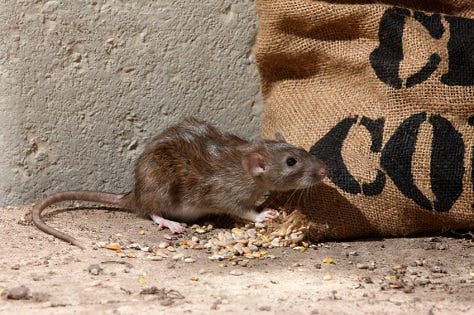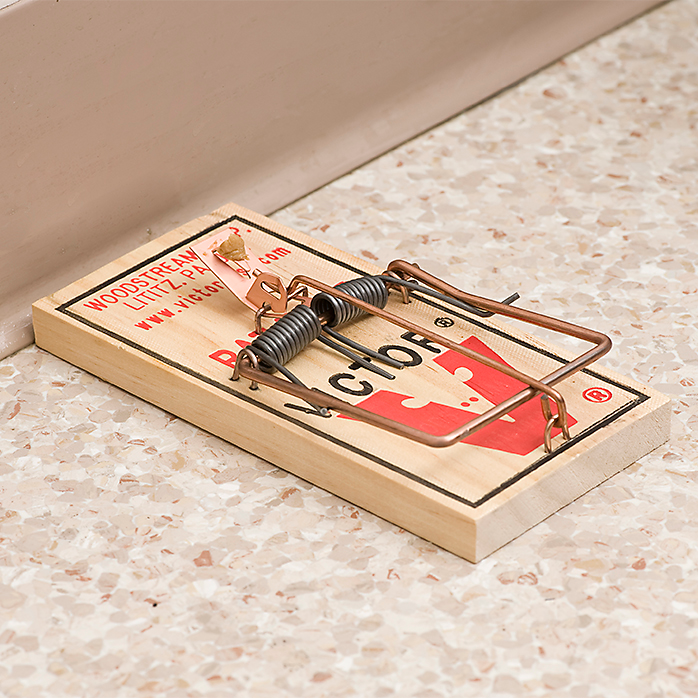Diy Easy Rat Zap
TIP 1: Place Rat Traps in the Right Places
Rats instinctively use walls and fences as guides. Therefore, they are unlikely to roam into the center of a room or yard. As such, traps are usually most effective when placed along a wall and in a low-light setting. Rat traps are most effective when hidden along paths where rats are most likely to travel.
To increase your odds of catching the critters, place traps inside closets, as well as under any furniture — like sofas, chairs or even cabinets — sitting along the walls. A clever way to lure rats into traps is to cut a hole on each side of a shoebox and place it along a suspected rat path with a baited trap inside. The box piques the rats curiosity on what's inside — and once they go in, they won't come back out.
Shop Victor® Rat Snap Traps 
TIP 2: Bait Traps According to a Rat's Diet
The best bait for a rat trap could all depend on the species of rat you're trying to catch. Different species eat different types of food. For instance, black rats are herbivorous creatures, but brown rats are omnivorous by nature.
Black rats, which scale trees and enter homes through coin-sized holes in attics, find peanut butter irresistible. Brown rats, which typically rummage through garbage and snake their way inside homes via tiny cracks, can be tempted with a smelly cheese.
Regardless of if you're dealing with a vegetarian or an omnivore, however, food with strong smells — nuts, fish or moldy cheese — are best at luring rats into traps. Check out our baiting guides for brown and black rats.
TIP 3: Teach Rats to Trust Traps
Even though rats have tiny heads, they are not as naive as people often assume. A rat will be suspicious of new objects in its environment. This applies to rat traps, which could fail to lure prey if placed cold turkey out in the open.
When an infestation persists, one of the more effective methods of elimination involves getting rats accustomed to traps before setting them. To introduce a trap, place it in an active area but don't set it. Allow rats to feed off this "safe" trap for a day or two. Once the critters have accepted this object as part of their regular turf, bait the trap again, but set it up to snap the next rat that crosses its path.

TIP 4: Repel Rats From Invading
If you don't have the heart to kill rats but understand all the reasons why you can't have them as house guests, there's a high-tech method for repelling the critters outright. With theVictor® Ultra PestChaser® , you can keep your house happily rodent–free without the use of traps.
The device emits piercing oscillations in a range of frequencies that only rodents can hear. To the ears of a rat, the sounds are deafening. Set one Ultra PestChaser® up in your attic, as well as one in your basement, and watch as all signs of rat activity cease within your home. No rat traps to set up, no carcasses and no mess.
Shop Victor® Ultrasonic Repellents
TIP 5:Poison-Free Bait
Just because a trap hasn't snapped doesn't mean it hasn't had a visitor. It just means the rat in question was sly enough to pry away the bait without getting caught. If the snap trap didn't do the trick the first time, simply try it again. There's really no reason to add slow-working chemicals into the process considering how traps are designed to kill on contact.
Mixing poison with edible bait can cause numerous problems. For example, if a rat gets away with the bait and drags it across the floor, that poison could potentially spread through your flooring. This can be hazardous to any bare feet that cross over the area, especially if you have pets or children in the house.
Furthermore, poisoned bait increases the odds of a rat meeting its slow death in another part of the house. In that case, you could have difficulty locating its stinky, rotting corpse.
For the best chances of catching a rat in the trap, keep the bait small and centered on the trap. If you bait a trap with a dangling piece of shrimp, for instance, a rat could nab it by the tip, set off the trap harmlessly and feast on its treat elsewhere.
Shop Victor® Rat Snap Traps
TIP 6: Use the Right Rat Trap
The house mouse averages 2.5 to 4 inches in length, with an additional length of equal measure for its tail. By contrast, the brown rat, also known as the Norway Rat, has a body that typically measures between 7 to 10 inches in length, with an additional 6 to 8 inches for its tail. With all things considered, rat traps need to be much larger than mouse traps. The trouble is, a lot of homeowners barely know the difference between rats and mice, let alone how to determine whether an infestation involves one or the other.
Before you can pick the best trap for the situation, it's crucial to determine whether you're dealing with a rat or mouse. For starters, the paw prints of a brown rat are typically around 20mm in width, whereas mice paw prints are generally under 10mm wide. Likewise, rat droppings are about the size of pumpkin seeds, and mice droppings are more the size of sunflower kernels. Additionally, mice tend to nest inside homes around the clock, whereas rats are often active indoors and out.
Because of the difference in size of the two rodents, rat traps are at least twice the size of mouse traps. The large yellow pedal on theVictor® Easy Set® Rat Trap is specifically designed with the proper measurements to take down rats in a single snap. The smaller pedal and kill-bar on theVictor® Metal Pedal Mouse Trap, meanwhile, is perfect for catching mice, but it is insufficient if the problem at hand involves rats.
Shop Victor® Traditional Rat Snap Traps
TIP 7: Wear Gloves When Holding Rat Traps
When you set up and bait a snap trap, like ourVictor®Power-Kill™ Rat Trap, it's best to wear gloves and apply the bait with kitchen utensils. The reasons for this are simple. Rats are generally afraid of human smell, and they can often detect it from the oil left by fingerprints. If you do happen to touch a trap with your bare hands, wash it off with hot water before setting it. While fingerprints won't render traps totally ineffective, your chances of trapping a rat improves when your scent is absent from the trap itself.

TIP 8: Use Electronic Rat Traps for Indoor Solutions
If the problem areas are anywhere within your home, garage or office, theVictor® Electronic Rat Trapis a convenient and powerful alternative to conventional snap traps. Operating on four C-size batteries, this mailbox-like device lures rats inside and kills them instantly with a 4,000-volt shock.
The Victor® Electronic Rat Trap is easy to set up and operate, and the trap requires no food bait. It also kills up to 50 rats on one set of batteries, and you don't even have to see or touch the corpse. A flashing light on the device signals when a kill has occurred.
Another option Victor® offers is the Victor® Smart-Kill™ Electronic Rat Trap. This innovative Wi-Fi-enabled trap pairs with the Victor® Pest App on your smartphone or other mobile device and sends a notification to alert you of a catch, letting you know when it's time to empty the trap without having to check. This trap also kills up to 50 rats on one set of batteries.
Shop Victor® Electronic Rat Traps
TIP 9: Use as Many Traps as Needed
If you suspect your problem is down to a single rat, you'll likely be able to solve the problem with one or two strategically placed traps. If, however, there's an infestation on your property, you'll probably need to place a dozen or so traps all around your house.
The problem could also manifest in your garage or backyard, in which case it would be helpful to make your property less inviting. This is possible if you tightly seal away garbage, rake leaves away from structures and keep all kindling and firewood stored at least one foot above ground.
With your property now less rat-friendly, place several traps along your backyard fence, the sides of your house and along the walls of your crawlspace and attic. Add more along any paths of suspected activity within your main living area, just in case.
Shop Victor® Bulk Rat Traps
TIP 10:Place Traps Properly Alongside Walls
There are two clever reason why rats travel alongside walls: First, they use their whiskers to sense objects in front of them in the dark. By keeping one set of whiskers touching a wall, they can tell if they are still on the right path. Secondly, traveling along a wall provides protection – they only have to watch for trouble on the open-air side of their path.
Therefore, a trap is most effective when it is placed against a wall at a 90-degree angle, with the trigger side placed closest to the wall.

If you must place a trap parallel to a wall, place it toe-to-toe with another trap facing the opposite direction. This will make it easier to catch a rat coming from either direction. Otherwise, keep your traps spaced at least 15 feet apart from one another.
TIP 11: Trap Rats Outside Before They Get In
When rats invade a house, it's likely because of a swelling rat population somewhere nearby. If they've invaded your house but not your neighbor's, it's only because your house is less secure. However, sealing the gaps and plugging the holes in your walls, roof, windows and vents is just part of the battle. You also need to deny them useful paths to move around your property.

For instance, one of the most common ways for black rats to access roofs is by climbing trees and crawling across overhanging branches. If you have this problem, trim your branches back and don't allow any tree or bush extensions to be within three feet of your walls or roof. Employ baited snap traps along the fences, trellises and tree branches of your property to further prevent these rodents from getting into your property. Use wire to secure traps to branches, rafters and roof pipes, if need be.
TIP 12: Don't Trap 'Em — Zap 'Em
While basic snap traps are powerful, and box-covered traps are even more potent, a step above all of those simpler trapping devices is theRat Zapper Ultra Rat Trap. Operating on four D-size batteries, this thin device fits conveniently alongside walls with its rectangular shape. You simply bait the inside with peanut butter, flip the on-switch and allow the Zapper to do its trick.
Once a rat has been caught, a red light flashes. Then, you empty the rat into a sealable plastic bag, re-bait and place the Zapper back in the rat's path for another kill. The Zapper kills rats instantly with a powerful 8,000-volt zap. Clean and easy, you never have to touch the rat itself. The Zapper handles all the dirty work.
Shop Rat Zapper® Electronic Traps
TIP 13: Trap Rats Outdoors to Inhibit Repopulation
Plan ahead to eradicate a large group of rats in one night. To do so, select a bait area, such as a pile of grains, bark or other natural areas where rats congregate. Then bait a large number of traps with peanut butter, and leave them unset on in the area.
A few days after the baited traps have been discovered, set the traps and kill your rats en masse. This will seriously reduce their population, possibly to the point where they won't be able to repopulate. At the very least, these rodents will shy away from your property!
If your rat problems linger, repeat the plan as a whole: Bait unset traps for multiple days and then bait and set the traps to hit the rat population again.
TIP 14: Bigger Buildings Call for Bigger Operations
Eliminating rats from an office building or factory is a much larger mission than trapping rats infesting a home. If multiple floors are seeing signs of rats, you need to learn the root of the problem. They could be accessing these spaces via air vents, basements or even toilets. Once access points are identified, conquer these rodents with a sufficient number of traps.
Given how rats are likely to nest in basements and crawl spaces and travel through vents and wall cavities, traps should be placed along the walls of office rooms and hallways during off hours, as well as placing them in the lower, dark spaces at all times. If there's a large infestation in a trash room or around a dumpster area, a mass–trapping could be in order.
TIP 15: Use Rat Traps That Kill on Contact
The best rat traps are those that kill upon snapping — no suffocation or prolonged pain and suffering. The types of traps that achieve this include snap traps, electric traps and zapper traps. If the problem is indoors and you don't like the sight of rat corpses, use theVictor® Electronic Rat TraporRat Zapper Ultra Rat Trap, which work cleanly and discretely. If the rats are confined to your backyard, set up theVictor® Easy Set® Rat Trap along your outer walls and fences.
Remember to always clean your home thoroughly after trapping a rat or mouse.

Put an End to Rat Invasions With Victor®
If rats have been an issue on your property, Victor®wants to hear about your methods for solving the problem. Whether you've seen the critters scavenging in your backyard or nesting indoors, let us know your tactics for getting rid of rats by visiting our Facebook page and sharing your story in the comments section.
If you have questions about treating a rat or mouse infestation, contact us online or call our customer service center for personalized advice at 1-855-5-VICTOR.
Be sure to subscribe to our email newsletter for more articles and great deals on Victor® products.
Source: https://www.victorpest.com/articles/15-rat-trapping-tips
0 Response to "Diy Easy Rat Zap"
Post a Comment